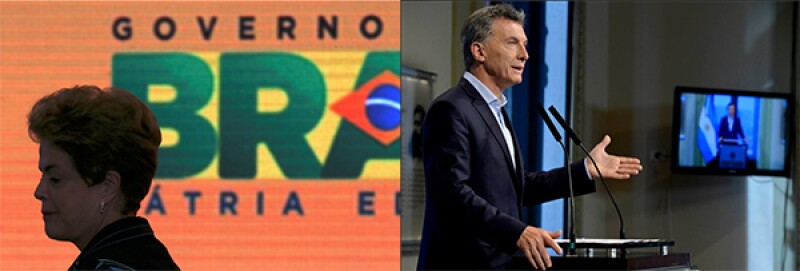
|
Brazil’s president Dilma Rousseff, Argentina's president Mauricio Macro |
Argentina blazed back into the international debt capital markets in late April with the largest-ever emerging markets debt sale, when it sold $16.5 billion in four tranches as investors backed the market-friendly programme of its new president, Mauricio Macro.
This followed Brazil’s first sovereign deal in two years, when it took advantage in March of a rally caused by the increased chance of the impeachment of president Dilma Rousseff.
In the case of Argentina, bankers shortened the execution period and showed restraint in increasing a book that reportedly reached $65 billion. One of the reasons the sovereign gave was to leave plenty of unsatisfied investor demand for Argentina exposure, which will benefit coming sub-sovereigns and corporates.
Meanwhile, in Brazil, a senior investment banker tells Euromoney that his international DCM team are ready to work for three days and nights to take advantage of the issuance window that he expects when the impeachment process clears the Senate. The reason for the rush? “To act before the dust settles and people begin to realize nothing has really changed.”
Sadly, the only similarities between Brazil and Argentina’s debt management programmes are current yields – with Argentina paying only 132bp more on its 10-year tranche, despite only just emerging from default and still being four notches below Brazil’s sovereign rating.
There are many reasons for the diverging credit stories, but perhaps the most relevant are the debt dynamics. Brazil’s gross debt-to-GDP is already the highest in mainstream emerging markets at 67.6% and, with low growth and high debt servicing costs (the base, Selic rate is 14.25%), it is set to grow quickly.
UBS estimates that by 2018 gross debt will be above 85% of GDP. Beyond this point, (generously) assuming growth of 2% would mean that Brazil would need a primary surplus of 3% to stabilize debt-to-GDP. If growth was 1% the surplus would need to be in the range of 3.5% to 4.0%.
With 90% of expenditures related to nondiscretionary spending, and with a fiscal take of 37% of GDP (with very poor services to show for it), Brazil will need very deep and effective structural reforms to head off a debt crisis in the medium term – something that looks far beyond the abilities of the country’s corruption-ridden political class.
Meanwhile, despite Argentina gorging on investor liquidity, its debt-to-GDP ratio is projected to rise to just 38% of GDP this year. Thereafter, the key variable is economic growth but Bank of America Merrill Lynch thinks that with intermediate growth (it calculates 3.5%, which, given the current base and the economic potential is surely realistic) the country will hit a debt ratio of 54.7% by 2025. Higher rates of growth, of around 4.5%, would see the debt stabilise and remain at 38% over the same period.
That divergence is the reason investors paid up for the Argentina bonds. And it is surely only a temporary situation that those yields are roughly similar, as Argentina’s financial position strengthens, while Brazil continues to weaken at an alarming rate.